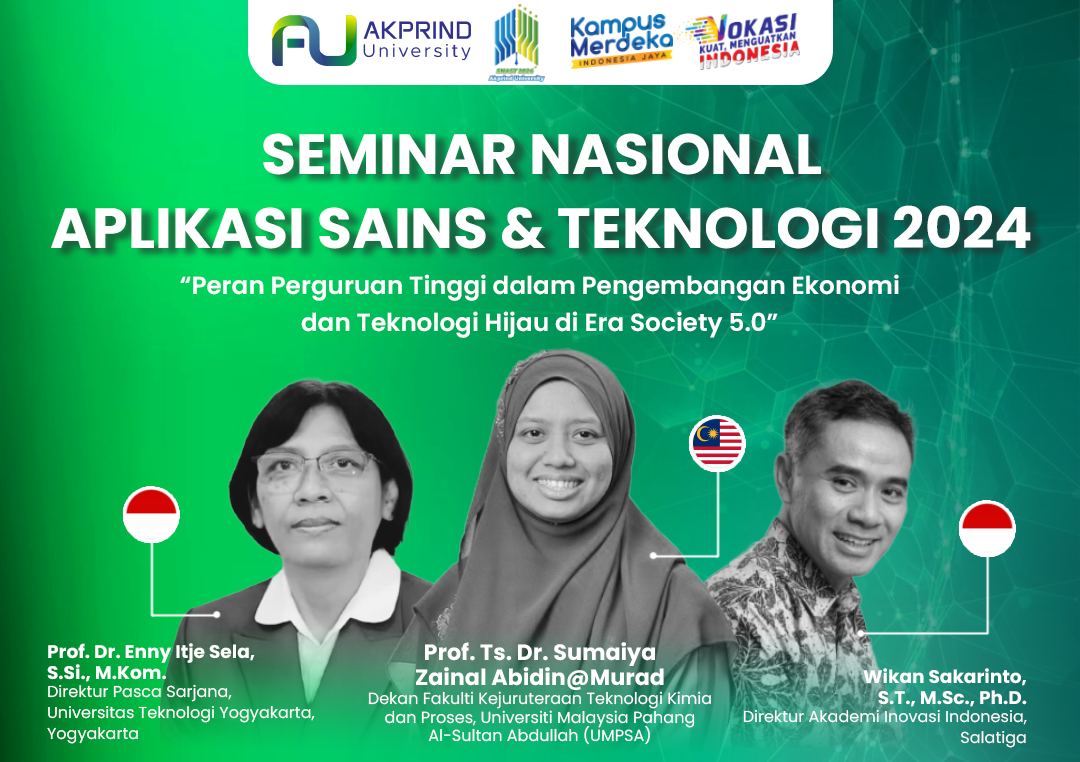SINTESIS NATRIUM SILIKAT DARI ABU HASIL GASIFIKASI SEKAM PADI
DOI:
https://doi.org/10.34151/prosidingsnast.v1i1.4945Keywords:
rice husk ash, gasification, silica synthesisAbstract
Soil degradation in Indonesia due to excessive use of chemical fertilizers leads to a decline in soil quality, increased toxicity, and environmental damage, which negatively impacts crop productivity. This study aims to synthesize sodium silicate from gasified rice husk ash as an alternative organic fertilizer and to determine the optimal operational conditions for the synthesis process. Organic fertilizers have the potential to improve soil structure and reduce compaction, while nano-fertilizer technology offers efficiency in nutrient release. The research was conducted in the Chemical Engineering Operations Laboratory at Universitas AKPRIND Indonesia, with varying soaking times in a 2 M NaOH solution of 45, 60, 75, and 90 minutes. The results indicate that the optimal soaking time for sodium silicate synthesis is 45 minutes, yielding 0.6 grams of sodium silicate with a yield of 12%. The increase in NaOH concentration is associated with the solubility of sodium silicate, but the results show the presence of unreacted excess NaOH. This study underscores the importance of optimizing soaking time and NaOH concentration to enhance the efficiency of sodium silicate production from rice husk ash and contributes to the development of more environmentally friendly and sustainable organic fertilizers within the context of modern agriculture. Furthermore, this research has the potential to open opportunities for farmers to reduce their dependence on chemical fertilizers, thereby supporting environmental sustainability. The implementation of sodium silicate as an organic fertilizer can improve soil health and crop quality. Additionally, the findings are expected to contribute to sustainable agricultural policies in Indonesia. Finally, the utilization of rice husk ash as a source of sodium silicate will enhance the added value of agricultural waste and support more efficient natural resource management.
References
Ayuni, H.R., Adrianto, D., & Krismayadi (2024). Pemanfaatan limbah sekam padi (Oriza sativa L.) sebagai pengisi pada tablet yang dibuat dengan granulasi kering. Indonesian Journal of Health Science, 4(5), 441-452.
Dewi, R.P. & Ardhitama, M.B. (2020, Oktober). Kajian potensi sekam padi sebagai energi elternatif pendukung ketahanan energi di wilayah Magelang. Dalam Prosiding Seminar Nasional Riset Teknologi Terapan (1540-1546). Fakultas Teknik, Universitas Tidar.
Lasindrang, M. (2018). Komposit nanosilika-kitosan “Pupuk lepas-lambat Si untuk tanaman padi”. Yogyakarta: Zahir Publishing.
Maarif, S. & Harahap, S. (2017). Optimasi gasifikasi sekam padi tipe fixed bed downdraft dengan menvariasikan hisapan blower supaya menghasilkan kandungan tar sesuai standar. Jurnal Teknik Mesin (JT), 06, 231-243.
Muhammad, A.A., Venisia, D.A., & Dewati, R. (2020). Sintesis komposit fiber-silika dari abu sekam padi dan pulp dengan metanol. Jurnal Teknik Kimia. 10(1). 34-38.
Mujiyanti, D.R., Ariyani, D., & Lisa, M. (2021). Silica Content Analysis of Siam Unis Husk from South Kalimantan. Indonesian Journal of Chemical Research (Indo. J. Chem. Res.), 9(2), 81-87.
Putra, E.A.P., Makmur, A., Rahmayanti, & Malau, A. (2022). Pengaruh waktu dan konsentrasi NaOH pada ekstraksi silika (SiO2) dari limbah fly ash batubara. Jurnal Teknologi Kimia Mineral, 1(2), 56-59.
Pranoto, B., Pandin, M., Fithri, S.R., & Nasution, S. (2013). Peta potensi limbah biomassa pertanian dan kehutanan sebagai basis data pengembangan energi terbarukan. Jurnal Ketenagalistrikan dan Energi Terbarukan, 12(2), 123-130.
Rahmatullah, Bahri, S., Ginting, Z., Suryati, & Nurlaila, R. (2022). Pengaruh Suhu dan Waktu Pembakaran terhadap Kadar Silika dari Abu Sekam Padi. Prosiding Seminar Nasional Fakultas Teknik Universitas Malikussaleh (995-1002). Fakultas Teknik Universitas Malikussaleh.
Rahmi. (2024). Sintesis silika alam dari kalsinasi sekam padi. Jurnal Pendidikan dan Sains, 4(1), 63-70.
Ramadhani, I., Oktavia, B., Putra, A., & Sanjaya, H. (2021). Penentuan kondisi optimum pembentukan natrium silikat (Na2SiO3) menggunakan material dasar silikat alam dan natrium hidroksida (NaOH). Chemistry Journal of Universitas Negeri Padang, 10(2), 22-26.
Susastriawan, A.A.P., Purwanti, A., & Rahayu, S.S. (2022). Konversi Limbah Sekam Padi menjadi Compressed Producer Gas. Serambi Enginering, 7(4), 3707-3708.
Trivana, L., Sugiarti, S., & Rohaeti, E. (2015). Sintesis dan Karakterisasi Natrium Silikat (Na2SiO3) dari Sekam Padi. Jurnal Sains dan Teknologi Lingkungan, 7(2). 66-75.
Utary, C.M., Nurlaila, R., Ibrahim, I., Sylvia, N., & Meriatna. (2023). Pengaruh waktu dan suhu pembakaran abu sekam padi pada proses ekstraksi silika dengan pelarut NaOH. Chemical Engineering Journal Storage Vol.3, No.4. Hal 469-480.
Downloads
Published
Issue
Section
License
Copyright (c) 2024 Ani Purwanti

This work is licensed under a Creative Commons Attribution-ShareAlike 4.0 International License.







